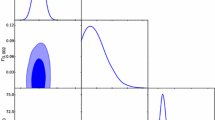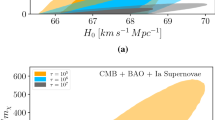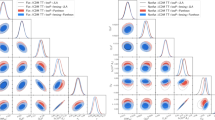Abstract
Cosmic microwave background (CMB) anisotropy (spatial inhomogeneity) data provide the tightest constraints on the Hubble constant, matter density, spatial curvature, and dark energy dynamics. Other data, sensitive to the evolution of only the spatially homogeneous part of the cosmological model, such as Type Ia supernova apparent magnitude, baryon acoustic oscillation distance, and Hubble parameter measurements, can be used in conjunction with the CMB data to more tightly constrain parameters. Recent joint analyses of CMB and such non-CMB data indicate that slightly closed spatial hypersurfaces are favored in nonflat untilted inflation models and that dark energy dynamics cannot be ruled out, and favor a smaller Hubble constant. We show that the constraints that follow from these non-CMB data alone are consistent with those that follow from the CMB data alone and so also consistent with, but weaker than, those that follow from the joint analyses of the CMB and non-CMB data.




Similar content being viewed by others
Notes
Hubble parameter measurements provide evidence for the earlier nonrelativistic matter dominated cosmological expansion as well as the current dark energy powered accelerating cosmological expansion (Farooq and Ratra 2013; Farooq et al. 2013; Capozziello et al. 2014; Moresco et al. 2016; Farooq et al. 2017; Yu et al. 2018; Jesus et al. 2018; Haridasu et al. 2018b).
For earlier discussions of cosmological constraints on the \(\phi \text{CDM}\) model see Samushia et al. (2007), Yashar et al. (1999), Samushia and Ratra (2010), Chen and Ratra (2011b), Campanelli et al. (2012), Avsajanishvili et al. (2015), Solà et al. (2017a,b), Zhai et al. (2017), Sangwan et al. (2018), and references therein.
This result differs from the Ade et al. (2016), Aghanim et al. (2018) finding. As mentioned above, and discussed in detail elsewhere, the Planck analyses used a physically inconsistent power spectrum for energy density inhomogeneities, a physically inconsistent generalization of the nonflat untilted inflation model (Gott 1982; Hawking 1984; Ratra 1985) energy density inhomogeneity power spectrum (Ratra and Peebles 1995; Ratra 2017).
We emphasize that these results refer to the cosmological parameter constraints, not to the goodness-of-fit of the best-fit set of cosmological parameters to the measurements. We find that the non-CMB data compilation we use here does not significantly distinguish between any of the best-fit models on the basis of goodness-of-fit. When the CMB data are included in the mix we are unable to quantitatively determine the goodness-of-fit of the best-fit set of cosmological parameters to the measurements. This is in part due to the ambiguity in the number of degrees of freedom of the Planck CMB data (see discussion in Ooba et al. 2018a,b,c,d; Park and Ratra 2018a,b,c). We also emphasize that qualitatively the slightly closed models better fit the lower multipole number CMB temperature anisotropy data and the weak lensing constraints on density inhomogeneities (Abbott et al. 2018) while the flat models better fit the higher multipole number CMB temperature anisotropy data and the observed deuterium abundances (Penton et al. 2018).
Although we use the parameter \(\theta _{\text{MC}}\), the approximate angular size of the sound horizon at recombination (Ade et al. 2014), instead of \(H_{0}\) in our \(\varLambda \text{CDM}\) and XCDM model analyses, we instead record the derived \(H_{0}\) as one of the main cosmological parameters for these models. For the \(\phi \text{CDM}\) model, however, \(H_{0}\) (not \(\theta _{\text{MC}}\)) is the active parameter in the MCMC analysis.
The \(H_{0}\) estimates here are consistent with many recent estimates based on non-CMB data (L’Huillier and Shafieloo 2017; Chen et al. 2017; Wang et al. 2017; Lin and Ishak 2017; Abbott et al. 2017; Yu et al. 2018; Haridasu et al. 2018a; Zhang et al. 2018; Gómez-Valent and Amendola 2018; Haridasu et al. 2018b; da Silva and Cavalcanti 2018; Zhang 2018) as well as with those from CMB data (Aghanim et al. 2018; Park and Ratra 2018a,b,c).
The main reason for the smaller \(\chi^{2}\) value in the nonflat \(\phi \text{CDM}\) model is that it fits the BAO data much better than do the \(\varLambda \text{CDM}\) and XCDM models.
References
Abbott, T.M.C., Abdalla, F.B., Annis, J., et al. (DES Collaboration): (2017). arXiv:1711.00403
Abbott, T.M.C., Abdalla, F.B., Alarcon, A., et al. (DES Collaboration): Phys. Rev. D 98, 043526 (2018). arXiv:1708.01530
Ade, P.A.R., Aghanim, N., Arnaud, M., et al. (Planck Collaboration): Astron. Astrophys. 571, A16 (2014). arXiv:1303.5076
Ade, P.A.R., Aghanim, N., Arnaud, M., et al. (Planck Collaboration): Astron. Astrophys. 594, A13 (2016). arXiv:1502.01589
Aghanim, N., Akrami, Y., Ashdown, M., et al. (Planck Collaboration): (2018). arXiv:1807.06209
Alam, S., Ata, M., Bailey, S., et al.: Mon. Not. R. Astron. Soc. 470, 2617 (2017). arXiv:1607.03155
Ata, M., Baumgarten, F., Bautista, J., et al.: Mon. Not. R. Astron. Soc. 473, 4773 (2018). arXiv:1705.06373
Aubourg, E., et al.: Phys. Rev. D 92, 123516 (2015). arXiv:1411.1074
Avsajanishvili, O., Samushia, L., Arkhipova, N.A., Kahniashvili, T.: (2015). arXiv:1511.09317
Bautista, J.E., Busca, N.G., Guy, J., et al.: Astron. Astrophys. 603, A12 (2017). arXiv:1702.00176
Beutler, F., Blake, C., Colless, M., et al.: Mon. Not. R. Astron. Soc. 416, 3017 (2011). arXiv:1106.3366
Campanelli, L., Fogli, G.-L., Kahniashvili, T., Marrone, A., Ratra, B.: Eur. Phys. J. C 72, 2218 (2012). arXiv:1110.2310
Capozziello, S., Farooq, O., Luongo, O., Ratra, B.: Phys. Rev. D 90, 044016 (2014). arXiv:1403.1421
Challinor, A., Lasenby, A.: Astrophys. J. 513, 1 (1999). arXiv:astro-ph/9804301
Chen, G., Ratra, B.: Publ. Astron. Soc. Pac. 123, 1127 (2011a). arXiv:1105.5206
Chen, Y., Ratra, B.: Phys. Lett. B 703, 406 (2011b). arXiv:1106.4294
Chen, G., Gott, J.R., Ratra, B.: Publ. Astron. Soc. Pac. 115, 1269 (2003). arXiv:astro-ph/0308099
Chen, Y., Ratra, B., Biesiada, M., Li, S., Zhu, Z.-H.: Astrophys. J. 829, 61 (2016). arXiv:1603.07115
Chen, Y., Kumar, S., Ratra, B.: Astrophys. J. 835, 86 (2017). arXiv:1606.07316
Conley, A., Guy, J., Sullivan, M., et al.: Astrophys. J. Suppl. Ser. 192, 1 (2011). arXiv:1104.1443
da Silva, G.P., Cavalcanti, A.G.: Braz. J. Phys. 48, 521 (2018). arXiv:1805.06849
Dhawan, S., Jha, S.W., Leibundgut, B.: Astron. Astrophys. 609, A72 (2017). arXiv:1707.00715
Farooq, O., Ratra, B.: Astrophys. J. 766, L7 (2013). arXiv:1301.5243
Farooq, O., Crandall, S., Ratra, B.: Phys. Lett. B 726, 72 (2013). arXiv:1305.1957
Farooq, O., Mania, D., Ratra, B.: Astrophys. Space Sci. 357, 11 (2015). arXiv:1308.0834
Farooq, O., Madiyar, F.R., Crandall, S., Ratra, B.: Astrophys. J. 835, 26 (2017). arXiv:1607.03537
Fernández Arenas, D., Terlevich, E., Terlevich, R., et al.: Mon. Not. R. Astron. Soc. 474, 1250 (2018). arXiv:1710.05951
Font-Ribera, A., Kirkby, D., Busca, N., et al.: J. Cosmol. Astropart. Phys. 1405, 027 (2014). arXiv:1311.1767
Gómez-Valent, A., Amendola, L.: J. Cosmol. Astropart. Phys. 0804, 051 (2018). arXiv:1802.01505
Gott, J.R.: Nature 295, 304 (1982)
Gott, J.R., Vogeley, M.S., Podariu, S., Ratra, B.: Astrophys. J. 549, 1 (2001). arXiv:astro-ph/0006103
Haridasu, B.S., Luković, V.V., Vittorio, N.: J. Cosmol. Astropart. Phys. 1805, 033 (2018a). arXiv:1711.03929
Haridasu, B.S., Luković, V.V., Moresco, M., Vittorio, N.: (2018b). arXiv:1805.03595
Hawking, S.W.: Nucl. Phys. B 239, 257 (1984)
Jesus, J.F., Holanda, R.F.L., Pereira, S.H.: J. Cosmol. Astropart. Phys. 1805, 073 (2018). arXiv:1712.01075
Jones, D.O., Riess, A.G., Scolnic, D.M., et al.: (2018). arXiv:1805.05911
Kim, Y.-L., Smith, M., Sullivan, M., Lee, Y.-W.: (2018). arXiv:1801.01192
Lewis, A., Bridle, S.: Phys. Rev. D 66, 103511 (2002). arXiv:astro-ph/0205436
Lewis, A., Challinor, A., Lasenby, A.: Astrophys. J. 538, 473 (2000). arXiv:astro-ph/9911177
L’Huillier, B., Shafieloo, A.: J. Cosmol. Astropart. Phys. 1701, 015 (2017). arXiv:1606.06832
Lin, W., Ishak, M.: Phys. Rev. D 96, 083532 (2017). arXiv:1708.09813
Macaulay, E., Nichol, R.C., Bacon, D., et al. (DES Collaboration): Mon. Not. R. Astron. Soc. 486, 2184 (2019). arXiv:1811.02376
Mitra, S., Choudhury, T.R., Ratra, B.: Mon. Not. R. Astron. Soc. 479, 4566 (2018). arXiv:1712.00018
Mitra, S., Park, C.-G., Choudhury, T.R., Ratra, B.: (2019). arXiv:1901.09927
Moresco, M., Pozzetti, L., Cimatti, A., et al.: J. Cosmol. Astropart. Phys. 1605, 014 (2016). arXiv:1601.01701
Moresco, M., Jimenez, R., Verde, L., et al.: Astrophys. J. 868, 84 (2018). arXiv:1804.05864
Ooba, J., Ratra, B., Sugiyama, N.: Astrophys. J. 864, 80 (2018a). arXiv:1707.03452
Ooba, J., Ratra, B., Sugiyama, N.: Astrophys. J. 869, 34 (2018b). arXiv:1710.03271
Ooba, J., Ratra, B., Sugiyama, N.: Astrophys. J. 866, 68 (2018c). arXiv:1712.08617
Ooba, J., Ratra, B., Sugiyama, N.: (2018d). arXiv:1802.05571
Park, C.-G., Ratra, B.: (2018a). arXiv:1801.00213
Park, C.-G., Ratra, B.: (2018b). arXiv:1803.05522
Park, C.-G., Ratra, B.: Astrophys. J. 868, 83 (2018c). arXiv:1807.07421
Pavlov, A., Westmoreland, S., Saaidi, K., Ratra, B.: Phys. Rev. D 88, 123513 (2013). arXiv:1307.7399
Peebles, P.J.E.: Astrophys. J. 284, 439 (1984)
Peebles, P.J.E., Ratra, B.: Astrophys. J. 325, L17 (1988)
Penton, J., Peyton, J., Zahoor, A., Ratra, B.: Publ. Astron. Soc. Pac. 130, 114009 (2018). arXiv:1808.01490
Rana, A., Jain, D., Mahajan, S., Mukherjee, A.: J. Cosmol. Astropart. Phys. 1703, 028 (2017). arXiv:1611.07196
Ratra, B.: Phys. Rev. D 31, 1931 (1985)
Ratra, B.: Phys. Rev. D 96, 103534 (2017). arXiv:1707.03439
Ratra, B., Peebles, P.J.E.: Phys. Rev. D 37, 3406 (1988)
Ratra, B., Peebles, P.J.E.: Phys. Rev. D 52, 1837 (1995)
Riess, A.G., Casertano, S., Yuan, E., et al.: Astrophys. J. 855, 136 (2018). arXiv:1801.01120
Rigault, M., Aldering, G., Kowalski, M., et al.: Astrophys. J. 802, 20 (2015). arXiv:1412.6501
Roman, M., Hardin, D., Betoule, M., et al.: (2017). arXiv:1706.07697
Ross, A.J., Samushia, L., Howlett, C., et al.: Mon. Not. R. Astron. Soc. 449, 835 (2015). arXiv:1409.3242
Ryan, J., Doshi, S., Ratra, B.: Mon. Not. R. Astron. Soc. 480, 759 (2018). arXiv:1805.06408
Ryan, J., Chen, Y., Ratra, B.: (2019). arXiv:1902.03196
Samushia, L., Ratra, B.: Astrophys. J. 714, 1347 (2010). arXiv:0905.3836
Samushia, L., Chen, G., Ratra, B.: (2007). arXiv:0706.1963
Sangwan, A., Tripathi, A., Jassal, H.K.: (2018). arXiv:1804.09350
Scolnic, D.M., Jones, D.O., Rest, A., et al.: Astrophys. J. 859, 101 (2018). arXiv:1710.00845
Solà, J., Gómez-Valent, A., de Cruz Pérez, J.: Mod. Phys. Lett. A 32, 1750054 (2017a). arXiv:1610.08965
Solà, J., de Cruz Pérez, J., Gómez-Valent, A.: (2017b). arXiv:1703.08218
Wang, Y., Xu, L., Zhao, G.-B.: Astrophys. J. 849, 84 (2017). arXiv:1706.09149
Wei, J.-J., Wu, X.-F.: Astrophys. J. 838, 160 (2017). arXiv:1611.00904
Yashar, M., Bozek, B., Abrahamse, A., Albrecht, A., Barnard, M.: Phys. Rev. D 79, 103004 (1999). arXiv:0811.2253
Yu, H., Wang, F.Y.: Astrophys. J. 828, 85 (2016). arXiv:1605.02483
Yu, H., Ratra, B., Wang, F.-Y.: Astrophys. J. 856, 3 (2018). arXiv:1711.03437
Zhai, Z., Blanton, M., Slosar, A., Tinker, J.: Astrophys. J. 850, 183 (2017). arXiv:1705.10031
Zhang, J.: Publ. Astron. Soc. Pac. 130, 084502 (2018)
Zhang, B.R., Childress, M.J., Davis, T.M., et al.: Mon. Not. R. Astron. Soc. 471, 2254 (2017). arXiv:1706.07573
Zhang, X., Huang, Q.-G., Li, X.-D.: (2018). arXiv:1801.07403
Acknowledgements
C.-G.P. was supported by the Basic Science Research Program through the National Research Foundation of Korea (NRF) funded by the Ministry of Education (No. 2017R1D1A1B03028384). B.R. was supported in part by DOE grant DE-SC0019038.
Author information
Authors and Affiliations
Corresponding author
Additional information
Publisher’s Note
Springer Nature remains neutral with regard to jurisdictional claims in published maps and institutional affiliations.
Rights and permissions
About this article
Cite this article
Park, CG., Ratra, B. Measuring the Hubble constant and spatial curvature from supernova apparent magnitude, baryon acoustic oscillation, and Hubble parameter data. Astrophys Space Sci 364, 134 (2019). https://doi.org/10.1007/s10509-019-3627-8
Received:
Accepted:
Published:
DOI: https://doi.org/10.1007/s10509-019-3627-8




